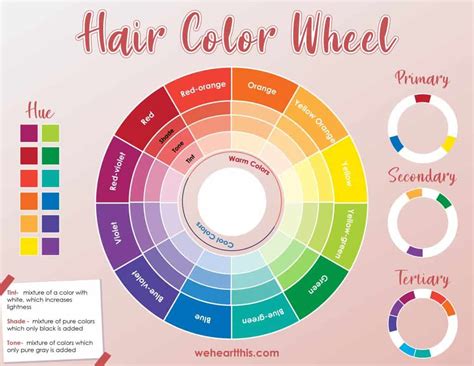Delving into the Hair Color Wheel
The hair color wheel is an essential tool for colorists and hair enthusiasts alike. It provides a comprehensive guide to the relationships between different hair colors, making it easier to create harmonious and visually stunning hair transformations.

Primary, Secondary, and Tertiary Colors
The hair color wheel consists of three primary colors: red, blue, and yellow. These colors cannot be created by mixing any other colors.
From the primary colors, six secondary colors are derived by mixing two primaries: orange (red + yellow), green (yellow + blue), purple (red + blue), red-orange, blue-green, and yellow-orange.
Finally, by mixing a primary and a secondary color, we obtain 12 tertiary colors: red-violet, red-orange, orange-yellow, yellow-green, green-blue, blue-violet, violet-red, violet-blue, blue-green, green-yellow, yellow-orange, and orange-red.
Understanding the Wheel
The color wheel is organized in a circular manner, with the primary colors evenly spaced around the perimeter. The secondary and tertiary colors occupy the spaces between the primaries, creating a gradient of hues.
Complementary Colors
Colors that are located opposite each other on the color wheel are known as complementary colors. When placed next to each other, they create a high contrast effect that can make hair colors pop. Some examples of complementary color pairs include:
- Red and green
- Blue and orange
- Yellow and purple
Analogous Colors
Analogous colors are those that are adjacent to each other on the color wheel. They create a more subtle and harmonious effect when combined, as they share similar undertones. Examples of analogous color combinations include:
- Red, red-orange, and orange
- Green, yellow-green, and yellow
- Blue, blue-violet, and violet
Triadic Colors
Triadic colors are three colors that are evenly spaced around the color wheel. They create a dynamic and eye-catching effect when combined. Some examples of triadic color combinations include:
- Red, yellow, and blue
- Orange, green, and purple
- Violet, red-orange, and green-blue
Applying the Hair Color Wheel
The hair color wheel can be used to create a wide range of hair color looks, from natural enhancements to vibrant fashion statements. Here are a few tips for using the color wheel:
Tips and Tricks:
- Identify your base hair color. This will determine the starting point for your color transformation.
- Choose a complementary color to neutralize unwanted tones. For example, if your hair has warm orange undertones, use a blue toner to counteract them.
- Use analogous colors to create a subtle but cohesive look. For example, combine dark blonde, light brown, and caramel highlights to enhance natural hair color.
- Experiment with triadic colors for a bolder statement. For example, a combination of red, yellow, and blue highlights can create a vibrant and eye-catching look.
Step-by-Step Approach:
- Determine your base hair color and identify any unwanted tones.
- Select a complementary color to neutralize those tones or an analogous color for a cohesive look.
- Use the color wheel to choose the appropriate tones for your desired effect.
- Consult with a professional stylist to discuss your options and get expert advice.
Hair Color Trends Inspired by the Color Wheel
The hair color wheel is a source of inspiration for countless hair color trends. Here are a few examples:
- Rainbow Hair: This trend involves using multiple colors from the hair color wheel to create a vibrant and multidimensional look.
- Ombre and Balayage: These techniques involve gradually transitioning from one hair color to another, creating a subtle and natural-looking gradient effect.
- Pastel Hair: Subtle and ethereal, pastel hair colors are created by mixing a bright color with a white or silver toner.
Customer Testimonials
“I love using the hair color wheel to create vibrant and unique looks for my clients,” says professional hairstylist Emily Carter. “It helps me achieve a harmonious blend of colors.”
“The hair color wheel has been an invaluable tool in my color journey,” shares hair enthusiast Sarah Jones. “It has empowered me to create the exact hair color I desire.”
Conclusion
The hair color wheel is an indispensable tool for understanding and creating beautiful hair color transformations. By understanding the relationships between different colors, you can unleash your creativity and create stunning hair looks that turn heads wherever you go.
Additional Resources
- Color Theory for Hair Colorists
- The Hair Color Wheel: A Guide for Stylists
- Hair Color Wheel: The Ultimate Guide
Tables
Table 1: Primary, Secondary, and Tertiary Colors
| Primary Colors | Secondary Colors | Tertiary Colors |
|---|---|---|
| Red | Orange | Red-orange |
| Blue | Green | Blue-green |
| Yellow | Purple | Yellow-orange |
Table 2: Complementary Color Pairs
| Color | Complementary Color |
|---|---|
| Red | Green |
| Blue | Orange |
| Yellow | Purple |
Table 3: Analogous Color Combinations
| Color | Analogous Colors |
|---|---|
| Red | Red-orange, Orange |
| Green | Yellow-green, Yellow |
| Blue | Blue-violet, Violet |
Table 4: Triadic Color Combinations
| Primary Colors | Secondary Colors | Tertiary Colors |
|---|---|---|
| Red, Yellow, Blue | Orange, Green, Purple | Red-orange, Yellow-green, Blue-violet |
